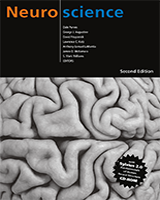By agreement with the publisher, this book is accessible by the search feature, but cannot be browsed.
NCBI Bookshelf. A service of the National Library of Medicine, National Institutes of Health.
Purves D, Augustine GJ, Fitzpatrick D, et al., editors. Neuroscience. 2nd edition. Sunderland (MA): Sinauer Associates; 2001.

Neuroscience. 2nd edition.
Show detailsThe account so far has already implied that language localization and lateralization does not simply reflect brain specializations for hearing and speaking; the language regions of the brain appear to be more broadly organized for processing symbols. Strong support for this conclusion has come from studies of sign language in individuals deaf from birth.
American Sign Language has all the components (e.g., grammar and emotional tone) of spoken and heard language. Based on this knowledge, Ursula Bellugi and her colleagues at the Salk Institute examined the localization of sign language in patients who had suffered localized lesions of either the left or right hemisphere. All these individuals were prelingually deaf, had been signing throughout their lives, had deaf spouses, were members of the deaf community, and were right-handed. The patients with lefthemisphere lesions, which in each case involved the language areas of the frontal and/or temporal lobes, had measurable deficits in sign production and comprehension when compared to normal signers of similar age (Figure 27.8). In contrast, the patients with lesions in approximately the same areas in the right hemisphere did not have sign “aphasias.” Instead, as predicted from other studies of subjects with normal hearing, visuospatial and other abilities (e.g., emotional processing and the emotional tone of signing) were impaired. Although the number of subjects studied was necessarily small (deaf signers with lesions of the language areas are understandably difficult to find), the capacity for signed and seen communication is evidently represented predominantly in the left hemisphere, in the same areas as spoken language. This evidence confirms that the language regions of the brain are specialized for the representation of symbolic communication, rather than for heard and spoken language per se.

Figure 27.8
Signing deficits in congenitally deaf individuals who had learned sign language from birth and later suffered lesions of the language areas in the left hemisphere. Left hemisphere damage produced signing problems in these patients analogous to the aphasias (more...)
The capacity for seen and signed communication, like its heard and spoken counterpart, emerges in early infancy. Careful observation of babbling in hearing (and, eventually, speaking) infants shows the production of a predictable pattern of sounds related to the ultimate acquisition of spoken language. Thus, babbling represents an early behavior that prefigures true language, indicating that an innate capacity for language imitation is a key part of the learning process. The congenitally deaf offspring of deaf, signing parents “babble” with their hands in gestures that are apparently the forerunners of signs (see Figure 24.1). Like babbling, the amount of manual “babbling” increases with age until the child begins to form accurate, meaningful signs. These observations indicate that the strategy for acquiring the rudiments of symbolic communication from parental or other cues—regardless of the means of expression—is similar in deaf and hearing individuals. These developmental facts are also pertinent to the possible antecedents of language in the nonverbal communication of great apes (see Box A).
- Sign Language - NeuroscienceSign Language - Neuroscience
- Cnpy1 canopy FGF signaling regulator 1 [Mus musculus]Cnpy1 canopy FGF signaling regulator 1 [Mus musculus]Gene ID:269637Gene
- Zfp619 zinc finger protein 619 [Mus musculus]Zfp619 zinc finger protein 619 [Mus musculus]Gene ID:70227Gene
Your browsing activity is empty.
Activity recording is turned off.
See more...